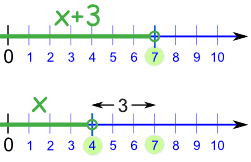How to Find the Median Value
It's the middle of a sorted list of numbers.
Median Value
The Median is the "middle" of a sorted list of numbers. How to Find the Median Value
To find the Median, place the numbers in value order and find the middle.Example 1 : find the Median of 12, 3 and 5
Put them in order:
3, 5, 12
The middle is 5, so the median is 5.
Example 2 :
3, 13, 7, 5, 21, 23, 39, 23, 40, 23, 14, 12, 56, 23, 29
When we put those numbers in order we have:
3, 5, 7, 12, 13, 14, 21, 23, 23, 23, 23, 29, 39, 40, 56
There are fifteen numbers. Our middle is the eighth number:
3, 5, 7, 12,
13, 14, 21, 23, 23, 23, 23, 29,
39, 40, 56
The median value of this set of numbers is 23.
(It doesn't matter that some numbers are the same in the list.)
Two Numbers in the Middle
In that case we find the middle pair of numbers, and then find the value that is half way between them. This is easily done by adding them together and dividing by two.
Example 3 :
3, 13,
7, 5, 21, 23, 23, 40, 23, 14, 12, 56, 23, 29
When we put those numbers in order we have:
3, 5, 7, 12, 13, 14, 21, 23, 23, 23, 23, 29, 40, 56
There are now fourteen numbers and so we don't have just one middle number, we have a pair of middle numbers:
3, 5, 7, 12, 13, 14, 21, 23, 23, 23, 23, 29, 40, 56
In this example the middle numbers are 21 and 23.
To find the value halfway between them, add them together and divide by 2:
21 + 23 = 44
then 44 ÷ 2 = 22
then 44 ÷ 2 = 22
So the Median in this example is 22.
(Note that 22 was not in the list of numbers ... but that is OK because half the numbers in the list are less, and half the numbers are greater.)
EXERCISE :
Find the median of the following numbers:
a) 4, 2, 7, 4, 15, 16, 18
b) 5, 2, 2, 3, 4, 11, 12, 12, 14
a) 4, 2, 7, 4, 15, 16, 18
b) 5, 2, 2, 3, 4, 11, 12, 12, 14


